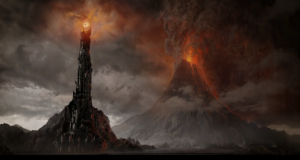“It is a barren wasteland, riddled with fire and ash and dust, the very air you breathe is a poisonous fume.”
Boromir, The Lord of the Rings

Mordor, the seat of the Dark Lord’s power, a barren wasteland crawling with orcs, dry and desolate. Or at least, that’s what we’re led to believe thanks to documentaries about the Ring War and other literature related to the great, but fallen kingdom. As one astute reader of the ancient texts point out “Orcs still have to eat, right?” (Shiffman, 2014).
So what is Mordor really like, when the cameras stop rolling?
Mordor is a combination of massive industrial powerhouse and agricultural heavy-weight. Mordor is among the most volcanically active regions in Middle Earth. While areas in the immediate vicinity of volcanoes like Amon Amarth are better suited for forging and other activities that take advantage of the incredible (and environmentally-friendly!) geothermal power, the constant rain of ash makes the land untenable, however volcanic soil is incredibly rich and makes for some of the best farming in the worlds. So we see, in Mordor, great garrisons and forges to the north, where the fires burn. However, in the south, Mordor is home to a vast inland sea, Núrnen, where the fields and farms that feed the amassed armies of men and orcs bear fruit. Mordor has agriculture, and, despite the incredibly dry climate, quite a lot of it.
Oh yes, Mordor is dry. Thanks to a thorough analysis of the climate of Middle Earth (also available in Elvish and Dwarvish) we know that Mordor receives at most 0.5 mm of rainfall per day. This is thanks to the rain-shadow effect of the Misty Mountains and the sub-tropical positioning of the kingdom–Mordor is affected by a Hadley cell. So even though climate would indicate that Mordor be more barren desert and less most-significant-kingdom-of-the-age, the combination of freshwater access and geology has led to some of the largest agricultural operations in all of Middle Earth. In fact, Mordor is rather similar to another geopolitical powerhouse–Southern California.
Or, at least, it was.
California is currently experiencing the worst drought in recorded history. With water tables dropping, wildfires raging, and the sea encroaching, it’s a wonder than humans continue to carve out settlements along this tortured coast. But, like the massive armies of Mordor, the population of Southern California continues to grow, and great fortress like that of Barad-Angeles fortify their walls against the onslaught. While Mordor enjoys up to 0.5 mm of rainfall a day, Southern California has suffered even greater drought, logging barely 0.14 millimeters per day since June 1.
Which means that, as the California drought continues, Southern California may actual be dryer, hotter, and less habitable than Mordor.